Summer officially kicks off this Friday with the occurrence of the Summer Solstice, the astronomical event that marks the longest day of the year in the Northern Hemisphere. At precisely 10:42 p.m. EDT on June 20 (or 0242 GMT on June 21), the sun will reach its highest point north of the celestial equator. This moment signifies the sun appearing directly overhead at the Tropic of Cancer, located at 23.5 degrees north latitude. That spot lies in the western Pacific Ocean, approximately 1,400 miles south of Tokyo, Japan.
In regions situated at mid-northern latitudes, the sun is never seen directly overhead. Yet, it does reach its annual peak altitude in the sky on this day. For instance, in Philadelphia, at 1:02 p.m. EDT during the solstice, the sun will reach its zenith for the year—soaring to 73 degrees above the southern horizon. To visualize this height, one can use a simple hand trick: a clenched fist held at arm’s length equals about 10 degrees. Using this method, Philadelphians would see the sun climb more than seven fists above the southern horizon. Because of this high arc across the sky, the city will experience the year’s longest span of daylight, precisely 15 hours.
However, this does not imply a full 9-hour window for stargazing after sunset. Twilight plays a crucial role in reducing the hours of true darkness. Around the June solstice at 40 degrees north latitude, both morning and evening twilight extend slightly over two hours each. As a result, there are only about five hours of complete darkness.
The higher the latitude, the longer twilight endures. At 45 degrees north, twilight stretches for two and a half hours. At 50 degrees, it persists all night, meaning the sky never becomes entirely dark. In contrast, further south, twilight is briefer. At 30 degrees latitude, twilight lasts 96 minutes, and in San Juan, Puerto Rico, it’s only 80 minutes. This phenomenon often surprises tourists from the northern United States when they notice how rapidly night falls in the Caribbean compared to their hometowns.
Interestingly, the solstice does not align with the year’s earliest sunrise or latest sunset. The earliest sunrise already happened on June 14, while the latest sunset will occur on June 27.
A common misconception is that Earth is closest to the sun during the summer solstice. In reality, the opposite is true. On July 3 at 3:55 p.m. EDT (19:55 Universal Time), Earth will reach aphelion, its farthest point from the sun in its elliptical orbit. At that time, our planet will be 94,502,939 miles (152,087,738 km) away from the sun.
Conversely, Earth reached perihelion, the closest point to the sun, on January 4. The difference between aphelion and perihelion is about 3,096,946 miles (4,984,051 km), roughly 3.277 percent. This variation translates into an approximate 7 percent difference in the solar energy received by Earth. In theory, this should mean milder summers and warmer winters in the Northern Hemisphere. However, the abundance of landmass in the Northern Hemisphere produces the opposite effect, generally resulting in colder winters and hotter summers compared to the Southern Hemisphere.
Following the solstice, the sun will begin its gradual migration southward, causing daylight hours in the Northern Hemisphere to slowly decline. Remarkably, after June 21, the days won’t begin to grow longer again until December 22, just three days before Christmas. Nonetheless, the sun has already been tracing a high path through the sky since mid-May, so the shortening of daylight immediately following the solstice will be quite subtle.
Some calendars mark August 1 as Lammas Day, a holiday derived from the Old English “loaf-mass.” Traditionally, this day celebrated the beginning of the harvest and was once considered the midpoint of summer. However, from a purely astronomical perspective, the actual midpoint of the summer season in 2024 lands on August 6 at 6:30 p.m. EDT. On that date in Philadelphia, the sun will set at 8:08 p.m., and the city will have lost just 56 minutes of daylight since June 20.
But the real effects of the sun’s southward shift begin to show more prominently during the latter half of summer. By the time autumn officially arrives on September 22, the sunset in Philadelphia will occur at 6:57 p.m., nearly an hour and ten minutes earlier than on August 6. The total loss of daylight from that midpoint of summer to the fall equinox will amount to 1 hour and 55 minutes.
This seasonal decline in sunlight even had practical implications for legendary New York Yankees catcher Yogi Berra during his Hall of Fame career. When he occasionally played in left field during late summer, he noted the difficulty of spotting fly balls due to the lengthening shadows as the sun sank lower in the sky. Berra, known for his quirky and memorable sayings, once summed up this natural shift with a unique phrase: “It’s getting late early out there.”
While Berra may not have known the specific astronomical mechanics behind the sun’s apparent movement and the waning daylight, his words captured the essence of late summer’s changing light in a way that was both poetic and accurate.
Thus, as the Summer Solstice ushers in the official start of the season, it also sets in motion the gradual reduction of daylight. While the change is barely noticeable in the days immediately following June 21, the shift becomes more prominent as summer progresses, affecting everything from sunset times to the colors of the sky—and even how Hall of Famers see baseballs in flight.

